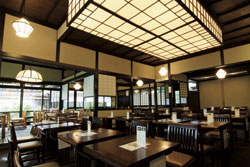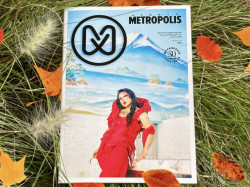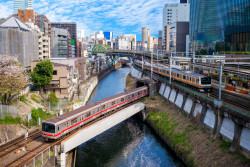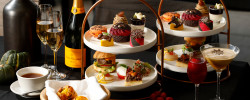
May 29, 2009
Spring slurping
Head to these classic restaurants to enjoy the city’s best soba
By Metropolis
Originally published on metropolis.co.jp on May 2009

Marie Wanibe
Soba is in the midst of a renaissance. The humble buckwheat noodle has been receiving an increasing amount of attention from local TV shows and lifestyle magazines, and a further boost has come from the Slow Food movement, which emphasizes locally procured ingredients and terroir. Here are seven Tokyo restaurants that should be on the itinerary of any noodle fan.
Kanda Yabu Soba
Soba aficionados from around the country trek to this fifth-generation shop, which first opened in 1880 (above). Entering through the compact garden is like stepping back into old Tokyo. If you’re hungry for more than noodles, the diverse menu includes dishes like sashimi yuba (¥900), tempura (¥1,400) and grilled nori (¥600). There is also a full range of seiro soba (cold noodles on a tray, ¥700).
2-10 Kanda-Awajicho, Chiyoda-ku. Tel: 03-3251-0287. Open daily 11:30am-8pm. Nearest stn: Ochanomizu. www.yabusoba.net; www.norenkai.net/english/shop/yabusoba/index.html (English)
Matsugen Soba
Contrast the vintage Kanda Yabu Soba with this modern shop in Ebisu. The communal tables are set in a dimly lit room—if you’re lucky, you can watch the noodles being rolled out and cut. Matsugen’s full menu includes an unusual bukkake soba that has a full dozen toppings (¥1,200), and an aromatic, toasty shirogoma-dare (sesame dipping sauce) that offers a nice contrast to the flavor of the noodles.
1-3-1 Hiroo, Shibuya-ku. Tel: 03-3444-8666. Open Mon-Sat 11:30am-3am, Sun & hols 11:30am-midnight. Nearest stn: Ebisu. www.pewters.co.jp
Nagasaka Sarashina
This ninth-generation soba shop has over 200 years of history behind it, and is famous for its pure, white sarashina noodles. Unlike the usual brown inaka soba, sarashina are made from buckwheat that’s polished to the core, resulting in a silky sheen. The basic mori soba (cold noodles) is served with two dipping sauces, amakuchi (sweet) and karakuchi (spicy), garnished with wasabi and julienned green onions (¥860). Diners can blend the sauces as they like.
1-8-7 Azabu-Juban, Minato-ku. Tel: 03-3585-1676. Open daily 11am-9pm. Nearest stn: Azabu-Juban, exit 5. www.nagasakasarasina.co.jp
Hanabusa
Off the beaten path in the shitamachi neighborhood of Monzen-Nakacho, this simple shop was recommended to me by a soba expert. While many restaurants on this list have a long history, the care and attention to the art of soba is particularly evident at Hanabusa. The shop offers three types of noodles: hearty inaka, classic Edo and the refined sarashina (all ¥700). For dessert, there’s soba ice cream (¥420) or dorayaki with sobako (soba flour), azuki and whipped cream (¥350).
2-2-15 Botan, Koto-ku. Tel: 03-3630-4337. Open Mon-Sat 11am-3:30pm and 5-11pm, closed Sun. Nearest stn: Monzen-Nakacho. http://homepage2.nifty.com/hanabusa
Narutomi Soba
Narutomi was brought to my attention by local food writers. Situated in the far reaches of Ginza, this little gem has white walls and dark wooden tables that set the stage for the handmade noodles. Start with the signature earthy gobo tempura (¥630), thin slices fried to a crisp garnished with salt, and the soba-gaki, a dense cake made from soba flour (¥1,050). The tsuyu dipping sauce is on the sweet side, a nice match for the rustic seiro noodles (¥840).
8-18-6 Ginza, Chuo-ku. Tel: 03-5565-0055. Open Mon-Fri 11:30am-3pm and 6-8:45pm, Sat 11:30am-3pm, closed Sun, hols & every third Sat. Nearest stn: Shimbashi or Higashi-Ginza. http://narutomi-soba.net
Toranomon Sunaba
This two-story wooden building commands a corner on a Toranomon back street where it feels like time has stopped. Inside, the brightly lit interior gives the restaurant a more modern feel—standard tables and chairs are on the first floor and tatami seating on the second. The menu is classic soba, with a dipping sauce that leans toward the sweet side without being cloying. The mori soba noodles are served with wasabi and julienned negi (¥700).
1-10-6 Toranomon, Minato-ku. Tel: 03-3501-9661. Open Mon-Fri 11am-8pm, Sat 11am-3pm, closed Sun & hols. Nearest stn: Toranomon, exit 1. http://tinyurl.com/sunaba
Tomoecho Sunaba
Operating in the same location for five generations, Tomoecho Sunaba dates back to the Edo period. Unlike many traditional soba shops, this restaurant is in a modern building with an interior that’s heavy on black granite. The osusume (recommended) dish is the tororo soba made from grated naga-imo, egg yolk and a medium-sweet tsuyu (¥1,470). The slippery, mousse-like sauce provides a nice contrast to the earthy noodles, and staff will serve a bowl of rice to finish any that’s left.
3-11-3 Toranomon, Minato-ku. Tel: 03-3431-1220. Open Sun-Fri 11am-3pm and 5-10pm, closed Sun & hols. Nearest stn: Kamiyacho, exit 3. http://tinyurl.com/tomoecho
What’s on the menu?
Serious soba aficionados refer to themselves as “sobaliers”—that is, sommeliers specializing in the art of soba
Sobaliers recommend enjoying your noodles unadulterated, as in the dish known as mori soba: cold with a dipping sauce. Eating it this way one can enjoy the aroma and texture of the noodles
The tsuyu (dipping sauce) is made from a dashi combined with a concentrated broth called kaeshi—a blend of soy sauce, sugar, and mirin
One sobalier suggests that you should dip only the bottom third of the noodles in the tsuyu, then carefully slurp up the noodles
Look for signs that say “teuchi soba” (手打ちそば), or handmade soba.
Yakumi (toppings) include negi, wasabi, grated daikon, and a sprinkling of spicy shichimi togarashi.
After finishing your noodles, the staff will bring out soba yu, some of the hot water that the soba was cooked in. This liquid is poured into the remaining tsuyu dipping broth to make a savory, creamy hot soup to finish your meal.
Inaka soba “rustic” noodles, dark in color
Kake soba soba noodles topped with a hot broth
Kamo Namban soba duck, negi, and hot broth
Kawari soba featuring different flavors incorporated into the dough, such as yuzu, shiso and matcha
Kitsune soba sweet abura-age (deep-fried tofu) with a hot broth
Mori soba cold noodles with a dipping broth
Sansai soba with young mountain vegetables harvested in the spring
Sarashina most of the shell of the buckwheat is milled away, creating delicate beige noodles
Seiro soba (aka Zaru soba) cold soba noodles on a bamboo zaru (tray) with a dipping broth
Sobagaki a dense mochi-like cake made from soba flour
Sobagaki zenzai sobagaki cake served with red bean paste
Tanuki soba tenkasu (tempura bits) with a hot broth
Teuchi soba handmade noodles
Tororo soba served with grated yama-imo and often a raw quail egg







